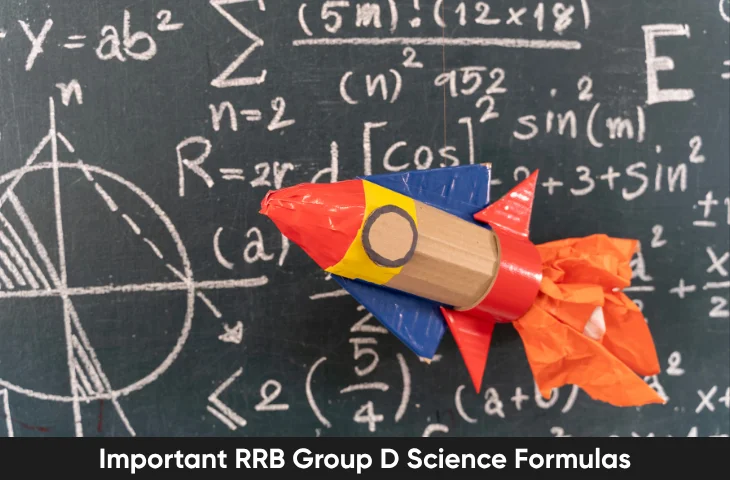RRB Group D Science Formulas: The RRB Group D Examination tests candidates not only on reasoning and general awareness but also on basic science concepts that are frequently used in daily life. In this section, many questions are direct formula-based, which means that if you memorize and understand the correct formula, you can score full marks in seconds.
This article compiles the most important RRB Group D science formulas across Physics, Chemistry, and Biology in an easy-to-understand format, along with preparation tips, examples, and quick revision strategies.
Why Science Formulas Matter in RRB Group D
In the General Science section of RRB Group D Syllabus, nearly 20–25 questions are asked. Out of these, 30–40% are formula-based, especially from Physics and basic Chemistry.
Mastering formulas helps you:
- Save time during the exam (no need for lengthy calculations).
- Eliminate wrong answer options quickly.
- Boost your overall accuracy in the General Science section.
Section-Wise Overview of Important RRB Group D Science Formulas
Below is a detailed subject-wise breakdown of formulas that are most frequently asked in RRB Group D examinations.
PHYSICS FORMULAS (Most Frequently Asked)
Physics contributes the maximum number of formula-based questions in the RRB Group D science section. Topics like motion, work, energy, power, and electricity are common.
Motion and Speed
| Concept | Formula | Unit |
| Speed | Speed=Distance/Time | m/s |
| Velocity | v=Displacement/Time | m/s |
| Acceleration | a = v-u/t | m/s² |
| Average Speed | Total distance/Total time | m/s |
Force and Motion:
| Concept | Formula | Unit |
| Force | F = Mass*Acceleration | Newton (N) |
| Newton’s 2nd Law | F=Rate of change of momentum | — |
| Momentum | P = Mass*Velocity | kg·m/s |
Work, Power, and Energy:
| Concept | Formula | Unit |
| Work | W=F×d×cosθ | Joule (J) |
| Power | P = W/T | Watt (W) |
| Kinetic Energy | KE=1/2 * (mv square) | Joule |
| Potential Energy | PE=mgh | Joule |
| Total Mechanical Energy | E=KE+PE | Joule |
Gravitation:
| Concept | Formula | Unit |
| Gravitational Force | F = G*(m1*m2)/r | Newton |
| Weight | W=m×g | Newton |
Heat and Temperature:
| Concept | Formula | Unit |
| Heat | Q=mcΔT | Joule |
| Conversion | °C = (°F – 32) × 5/9 | — |
| Conversion | K = °C + 273 | Kelvin |
Electricity:
| Concept | Formula | Unit |
| Ohm’s Law | V=I×R | Volt |
| Electric Power | P=V×I=I2R=RV2 | Watt |
| Resistance | R=ρ*L/A | Ohm (Ω) |
| Electrical Energy | E=P×t | Joule or kWh |
Wave and Sound
| Concept | Formula | Unit |
| Wave Speed | v=f×λ | m/s |
| Frequency | P=V×I=I2R=RV2 | Hertz (Hz) |
| Echo Distance | d=v×t/2 | meter |
CHEMISTRY FORMULAS
Chemistry questions are often direct, focusing on molecular weights, chemical equations, and basic reactions.
Chemical Formula Basics
| Concept | Formula | Example |
| Water | ( H_2O ) | Hydrogen + Oxygen |
| Carbon Dioxide | ( CO_2 ) | Carbon + Oxygen |
| Ammonia | ( NH_3 ) | Nitrogen + Hydrogen |
| Sulphuric Acid | ( H_2SO_4 ) | — |
| Methane | ( CH_4 ) | — |
Moles and Chemical Calculations
| Concept | Formula | Example |
| Mole | Given mass/Molar mass | mol |
| Number of Molecules | n×6.022×10 to the power 23 | molecules |
| Density | Mass/Volume | g/cm³ |
Gas Laws
| Concept | Formula | Law |
| Boyle’s Law | P1V1=P2V2 | Pressure ∝ 1/Volume |
| Charles’s Law | V1/T1 = V2/T2 | Volume ∝ Temperature |
| Ideal Gas Law | PV=nRT | — |
Acids, Bases, and Salts
| Concept | Formula |
| pH Formula | pH=−log[H+] |
| Neutralization | Acid + Base → Salt + Water |
| Example | HCl + NaOH → NaCl + H₂O |
BIOLOGY FORMULAS & KEY CONCEPTS
Although Biology doesn’t involve complex numerical formulas, some ratios and biological constants are frequently asked.
| Concept | Formula | Unit |
| Photosynthesis | ( 6CO_2 + 6H_2O → C_6H_{12}O_6 + 6O_2 ) | — |
| Respiration | C6H12O6+6O2→6CO2+6H2O+Energy | — |
| Human Body Temperature | 37°C | — |
| Normal Blood Pressure | 120/80 mmHg | — |
| BMI Formula | Weight/Height | kg/m² |
| Genetic Ratio (Mendel’s Law) | 3:1 (Dominant:Recessive) | — |
Quick Tips to Memorize Science Formulas
We have given below some quick steps to memorize the science formulas. Check out the details below:
- Use flashcards: Write formulas on one side and examples on the other.
- Revise with visual aids: Create mind maps linking concepts (e.g., motion → speed → force → work).
- Group formulas: Study similar formulas together (like electricity or motion).
- Daily revision habit: Spend 10 minutes revising formulas before bed.
- Use mnemonics: Example — “VIR” (Voltage = Current × Resistance).
Commonly Confused Formulas
Some of the commonly confused formulas are as follows”
| Confused Pair | Difference |
| Power vs Energy | Power = rate of work; Energy = total work done. |
| Heat vs Temperature | Heat = energy transfer; Temperature = measure of heat level. |
| Speed vs Velocity | Speed = scalar; Velocity = vector with direction. |
| Mass vs Weight | Mass = constant; Weight = depends on gravity. |
Key Points
Check out the key points for a quick overview:
- The RRB Group D science formulas focus mainly on Physics and basic Chemistry concepts.
- Expect direct one-line formula questions, especially from Motion, Work-Energy, Electricity, and Heat.
- Biology has fewer formulas but questions on processes and constants (e.g., respiration equation) are frequent.
- Daily revision, practice questions, and short notes will drastically improve recall speed.
- Understanding concept + formula application gives you an extra edge in tricky questions.
In the RRB Group D exam, every mark counts — and the General Science section offers one of the best scoring opportunities if you memorize key formulas systematically. The RRB Group D science formulas listed above will help you tackle direct as well as applied questions across Physics, Chemistry, and Biology.
FAQs
The most important topics include Physics (motion, work, energy, electricity, heat), Chemistry (basic reactions, gas laws, acids & bases), and Biology (photosynthesis, respiration, human body constants). Physics formulas contribute the maximum marks in the formula-based questions.
Effective methods include:
Creating flashcards with formulas on one side and examples on the other.
Grouping similar formulas together (e.g., all motion formulas in one set).
Daily 10–15 minute revision sessions before sleep.
Using mnemonics or visual charts to link concepts.
While biology has fewer numerical formulas, some important ones include:
BMI Formula:Weight/Height
Mendelian ratio in genetics: 3:1 (Dominant:Recessive)
Chemical equations for photosynthesis and respiration.
Typically, 5–10 questions out of 20–25 in the General Science section are formula-based. Most are from Physics and Chemistry, while Biology questions are conceptual. Accuracy in formulas can secure easy marks in these questions.
Yes. Some tips include:
Practice previous year questions to recognize patterns.
Use approximation methods where exact calculation isn’t required.
Solve problems in steps, using one formula at a time to avoid confusion.
- RRB Group D City Intimation Slip 2025, View City Slip and Shift Timings
- RRB Group D Vacancy Trend Analysis, Check Details
- रेलवे परीक्षा की तैयारी करें, सारी जानकारी यहां देखें
- RRB Group D Study Plan for 15 Days, Check Daily Schedule
- Important RRB Group D Exam Day Guidelines, Check Now
- Important Biology Chapters for RRB Group D Exam, Know Details

Hello! This is Arijit Dutta. I am a skilled Content Writer at Oliveboard with nearly 3+ years of experience in crafting engaging, informative, and exam-focused content for the Railways Domain. With a strong command of language and a keen understanding of learner needs, I contribute significantly to Oliveboard’s mission of delivering high-quality educational resources. Passionate about clear communication and continuous learning, I consistently create content that helps government job aspirants achieve their goals. Outside of work, I enjoy playing cricket and listening to music, which helps me stay balanced and creative in my professional journey.
